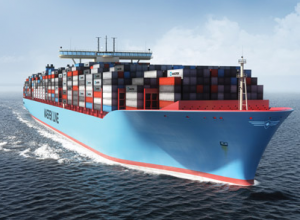The container shipping industry may face a wave of mergers as carriers try to cushion themselves from the current crisis and grow to lower costs and improve access to funding.
Hamburg-based Hapag-Lloyd AG, the world’s sixth-largest container line, is in merger talks with Hamburg Sued, the No. 12, to create the world’s fourth-largest carrier. The two lines together would have capacity less than only A.P. Moeller-Maersk A/S, CMA CGM SA and Mediterranean Shipping Co. While Hamburg Sued focuses on North-South trade, Hapag-Lloyd mainly operates on East-West lanes such as Asia to Europe.
Carriers have struggled to make profits in the past two years because of an overcapacity of vessels, slumping demand and low freight rates. Maersk Line, the world’s largest container carrier, has higher profitability than rivals because of its size, suggesting that economies of scale are key in shielding the industry from downturns. The world’s top four lines control 41 percent of global container capacity, according to data provider Alphaliner SA.
“One reason why you need a certain size is to be able to be competitive on the biggest trade lanes and to get access to larger tonnage,” Kai Miller, Hamburg-based head of the container desk at London ship broker ICAP, said in a phone interview. “There might also be a chance that some organizations perfectly complement each other, either through their activity in specific trades or through the existence of excellent management and organizational structures.”
Share Sale
Hapag-Lloyd had been planning an initial public offering before merger talks with Hamburg Sued were announced, as has France’s CMA CGM. Costamare Inc. (CMRE), the Greek owner of 58 chartered container ships, sold 7 million shares at $14 per share in October to raise cash for ship purchases.
Maersk Line (MAERSKB) operates 600 ships with capacity of 2.6 million standard containers, making it the world’s No. 1, according to Paris-based Alphaliner. Hapag-Lloyd has an equal amount of trade on its Far East, Atlantic, Latin American and transpacific routes, between 22 and 23 percent in 2011. That means it’s less vulnerable to downturns on one line and that it can compensate slumps in rates on one route by raising prices on another.
“Container shipping is the epicenter of economies of scale, so if you are able to lower your unit cost per box that you handle you may be able to get a small profit when your competitors run a deficit,” said Peter Sand, an analyst at BIMCO shipping association in Bagsvaerd, Denmark. “That will give you the upside.”
No Wave?
Still, he doesn’t expect an outbreak of mergers in the industry in coming years as a lot of the potential consolidation has already taken place. France’s CMA CGM, based in Marseille, was created through the merger of Cie. Maritime d’Affretement and CGM in 1996. It then acquiredAustralia’s ANL in 1998. Taiwan’s Evergreen Marine Corp. (2603) has swallowed companies including Uniglory and Italia Marittima in the past few decades. Maersk has taken over lines including Sea-Land Services’ container operations and Royal P&O Nedlloyd.
Some carriers without strong government ties “may find themselves in an extremely difficult financial situation where a merger with a more financially sound partner may be one of the only ways going forward,” said Sand, declining to comment on what container carriers may be merger candidates.
Hapag-Lloyd spokesman Rainer Horn declined to comment, while Hamburg Sued didn’t respond to requests for comment.
Funding Access
Hapag-Lloyd and Hamburg Sued said on Dec. 18 last year that their executive boards, in agreement with their owners, are “investigating if and under what conditions a merger of both companies would be of interest.” Rahul Kapoor, a Singapore- based analyst at Drewry Maritime Equity Research, said a merger would have operational benefits, increase the revenue base and lead to cost savings for the two German carriers.
Still, “the key is relatively easier access to funding,” Kapoor said. “Capital markets like size.”
An exit by many banks from ship financing, including Commerzbank AG’s decision last year to withdraw from maritime lending and HSH Nordbank AG’s plan to reduce its shipping balance sheet, has exacerbated the maritime industry crisis.
Banks such as DNB ASA (DNB) and Nordea Bank AB (NDA) still lend to the industry, typically using money paid back on existing loans to finance new credit. Still, European lenders face stricter capital requirements, making them more cautious on new lending than during the shipping industry’s boom years.
Total Capital
Maersk Line’s earnings before interest and taxes was $129 per standard container, or TEU, in the third quarter, compared with an industry average of $65 per TEU, according to Dan Togo Jensen, an analyst with Svenska Handelsbanken AB in Copenhagen. That put Maersk among the top three highest earners in the quarter, according to Jensen.
“Maersk Line’s profitability is driven by its size,” Jensen, who has a buy recommendation on the stock, said by phone. “Profitability in the third quarter was also helped by a relative jump in freight rates on Asia-Europe, which is Maersk Line’s most important route.”
Of the total of 367 deals worth $91 billion in the shipping and offshore industry in the first 11 months of last year, banks supplied only $34.3 billion, or 38 percent, of the total capital, according to data from Marine Money International. At the industry peak in 2007, banks accounted for $129.2 billion, or 75 percent, of the total of $234.7 billion, the data shows.
The drying up of credit may result in more companies seeking to raise cash in IPOs, Miller said, declining to name potential candidates.
“You need to be big if you’re to order the biggest ships,” said Miller. “You need a lot of money and you need to have plenty of these big ships to be able to operate a route successfully. One is not enough.”







Comments
Post a Comment